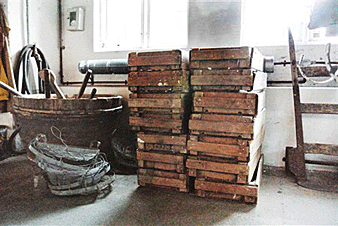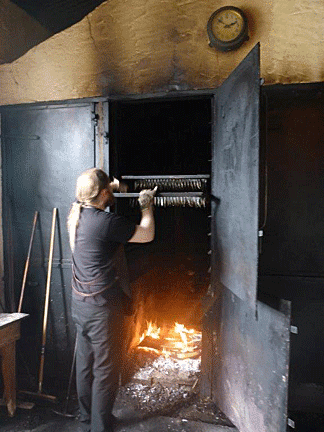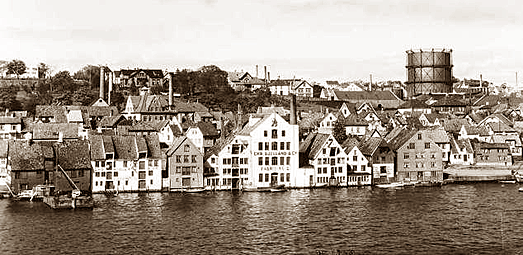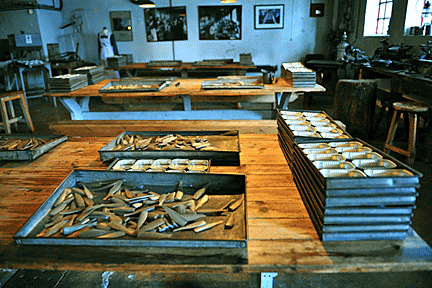The King of Canned Fish
by Bob Brooke
 Who is the king of sardines? King Oscar, of course. He ruled over Norway from 1872 to 1905,
but he’s best known as the face on millions of cans of sardines.
Artistically, the first King Oscar labels depicted a weak-looking king.
His Majesty wasn’t at all pleased. The marketing department of the
Christian Bjelland & Company cannery realized this, so they updated the
king’s image, giving him wider shoulders, more hair, and a fuller
moustache, all of which radiated the joy that should follow after a
person ate Mr. Bjelland’s sardines. Who is the king of sardines? King Oscar, of course. He ruled over Norway from 1872 to 1905,
but he’s best known as the face on millions of cans of sardines.
Artistically, the first King Oscar labels depicted a weak-looking king.
His Majesty wasn’t at all pleased. The marketing department of the
Christian Bjelland & Company cannery realized this, so they updated the
king’s image, giving him wider shoulders, more hair, and a fuller
moustache, all of which radiated the joy that should follow after a
person ate Mr. Bjelland’s sardines.
The Stavanger Preserving Company established the first canning factory
in
Stavanger for the production of canned meals for the merchant fleet
in 1873. Two years later, Torkild Aarestad of Stavanger, and a German,
began smoking brisling, another name for sardines, at a small smokehouse
on Strandgatea Street in Stavanger. They named the product
Kielersprut and sold it both locally and in Germany.
 The method of canning sardines was simple. Men brought the fish up from
the docks in wooden crates. Women then put the fish in salt water for
three to seven minutes. They worked 10 hours a day and earned one kroner,
30 ute. Their shoes alone cost 9 kroner. The owners of these canneries
paid the men double. The method of canning sardines was simple. Men brought the fish up from
the docks in wooden crates. Women then put the fish in salt water for
three to seven minutes. They worked 10 hours a day and earned one kroner,
30 ute. Their shoes alone cost 9 kroner. The owners of these canneries
paid the men double.
In 1878, Martin Gabrielsen of Stavanger opened a smokehouse on Sandvigå
Street, where, together with Torkild Aarestad as his smoker, he
continued his production of Kielersprut.
The Appearance of Soldered Cans
 In 1879, Martin Gabrielsen and the manager of the Stavanger Preserving
Company, Johan G. Mejlænder began producing smoked brisling packed in
soldered cans. After the lids had been soldered on, cannery workers
boiled the cans in open pans at 1832 F. Gabrielsen took care of the smoking while Mejlænder managed the
packing, boiling, and marketing. They called their product Røgede
Norske Sardiner, or Smoked Norwegian Sardines. But Gabrielsen became
ill and the partnership ended. In 1879, Martin Gabrielsen and the manager of the Stavanger Preserving
Company, Johan G. Mejlænder began producing smoked brisling packed in
soldered cans. After the lids had been soldered on, cannery workers
boiled the cans in open pans at 1832 F. Gabrielsen took care of the smoking while Mejlænder managed the
packing, boiling, and marketing. They called their product Røgede
Norske Sardiner, or Smoked Norwegian Sardines. But Gabrielsen became
ill and the partnership ended.
Mejlænder went to Germany to study food smoking in 1880. He returned to
Stavanger and installed the first German-made Wildhagen chamber
smoking oven in the Stavanger Preserving Company’s cannery on Øvre
Strandgate Street. And sales of sardines rocketed once again. The
company now installed a French pressure cooker, known as an autoclave.
Workers could now sterilize the sardines at 1940 F., thus prolonging their shelf life.
Stavanger Preserving
Company acquired a gas-driven mechanical press from the U.S. for
stamping out lids and cans directly from sheet metal.
By 1885, there were 18 sardine canneries in Norway, most of them located
in old warehouses where workers did most of the production by hand..
Five years later, most of the canneries used the three-piece, soldered
French can.
The number of sardine canneries in Norway had grown to 38, with 14 of
them in Stavanger by 1900, by which time canneries had began attaching
keys to open the tins.

New Inventions Revolutionize the Industry
Until 1905, canneries used little machinery, thus the volume of cans
produced remained relatively small. A string of inventions by men from Stavanger resulted in an increasing number of machines and technical
devices being adopted by the industry. The quantities both of cans
produced and of those sold increased significantly.
 The invention of the deep drawn can, Reinert’s seaming machine, and
Opsal’s press tool revolutionized the production of cans, and forced the
French type of cans out of the market. The invention of the deep drawn can, Reinert’s seaming machine, and
Opsal’s press tool revolutionized the production of cans, and forced the
French type of cans out of the market.
Next came a combined cutting, pressing and trimming tool which
considerably simplified can production and increased daily production
could increase to 20,000 cans per press.
The French sardine industry brought a lawsuit against the Norwegian
sardine cannery owners, claiming that smoked Norwegian brisling should
not be called or sold as smoked sardines. The French claimed sole rights
to the use of the word “sardine” for their sardines. The case dragged on
for 10 years, ending with a French victory.
 In 1905, the women cut the heads off the fish with scissors. And they
soldered the lids on the cans by hand. Good workers could each solder
500 tins per day, producing 7,000 to 8,000 cans daily for the cannery. In 1905, the women cut the heads off the fish with scissors. And they
soldered the lids on the cans by hand. Good workers could each solder
500 tins per day, producing 7,000 to 8,000 cans daily for the cannery.
In 1907, Johan Tjaaland launched the first practical decapitating
machine for cutting the heads of the fish—not the workers. It used
horizontal rotating knives. However, one year later Hans J. Larsen
introduced a machine which was far superior to Tjaaland’s. Larsen’s
machine had a rotating blade which ran on two large wheels and
efficiently removed the heads of the fish. The machine became known
as the båndklippemaskin, or band-cutting machine.
Fishermen began to use purse nets in 1908, which resulted in more
efficient fishing. The phenomenal growth in the sardine industry,
together with variable catches of brisling, averaging half a million
crates of 5.2 gallons each, corresponding to roughly 50 million cans
per year, created a shortage of fish. The canneries began to use
young herring, called mussa, instead. And once again
production skyrocketed to 100 million cans.
In 1910, John Braadland Ltd. purchased the property at 88 Øvre
Strandgate Street where the Norwegian Canning Museum now stands, for
use as a store and for the production of anchovies. The building
dates from 1875 and originally housed one of the town’s largest
tanneries. He later added the smokehouse for production of smoked
sardines.
Lawsuits
 The lawsuits over the right to use the name “sardine” came to an end
in 1914. The Norwegian canneries lost, so they had to stop using the
word “sardine” in Europe and change it to “smoked brisling” or
“smoked herring.” However, there wasn’t a restriction on using the
word “sardine” in the U.S. or the rest of the world, so the
canneries labeled their cans as “brisling sardines” or “herring
sardines,” for which they used young herring. The lawsuits over the right to use the name “sardine” came to an end
in 1914. The Norwegian canneries lost, so they had to stop using the
word “sardine” in Europe and change it to “smoked brisling” or
“smoked herring.” However, there wasn’t a restriction on using the
word “sardine” in the U.S. or the rest of the world, so the
canneries labeled their cans as “brisling sardines” or “herring
sardines,” for which they used young herring.
The demand for canned sardines increased with the start of the World
War I. By 1915, there were 128 sardine canneries in Norway, 48 of
them producing 350 million cans in Stavanger. But when the War
ended, demand plummeted and many of the canneries filed for
bankruptcy. Of the 180 producers in existence in 1919, only 50
survived.
Regulation Comes to the Sardine Industry
In 1933, the Norwegian Parliament, the Storting, passed a law that
regulated sardine canning. It established the A/S
Hermetikkfabbrikenes Brislingsentral, or Canning Factories Brisling
Distribution Center, governed the amounts of raw fish allowed to
each cannery, and permitted canneries to sell their products to the
Brislingsentral to be protected against loss. The law also prevented
the establishment of new canneries.
 By 1968, only 13 sardine canneries remained in Stavanger. But even
those few canneries had a problem securing adequate amounts of fish.
There were huge quantities of brisling along the coast of Scotland.
This saved the Norwegian sardine industry, which dispatched six
freezer ships, enabling the fishermen to freeze the fish and
transport it to Norway for processing. There were also several
Scottish land-based freezer plants which helped with the freezing.
By using fresh-frozen fish, the remaining 48 Norwegian canneries,
including those in Stavanger, produced 100 to 170 million cans per
year. By 1968, only 13 sardine canneries remained in Stavanger. But even
those few canneries had a problem securing adequate amounts of fish.
There were huge quantities of brisling along the coast of Scotland.
This saved the Norwegian sardine industry, which dispatched six
freezer ships, enabling the fishermen to freeze the fish and
transport it to Norway for processing. There were also several
Scottish land-based freezer plants which helped with the freezing.
By using fresh-frozen fish, the remaining 48 Norwegian canneries,
including those in Stavanger, produced 100 to 170 million cans per
year.
The end came in 1983, when Norway Foods ceased production at its
main cannery in Stavanger, and the last sardine cannery in Stavanger
closed. And while fishermen still catch King Oscar sardines in the
fjords of Norway, no canneries exist for them in the country. Now
the frozen fish travel to Poland to be canned.
< Back to A Taste of Scandinavia
Go to The Smorgasbord >
|